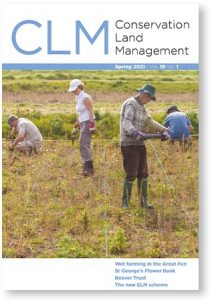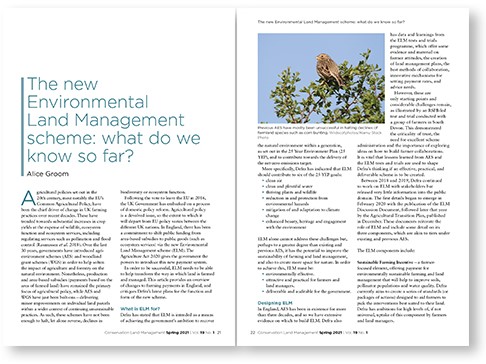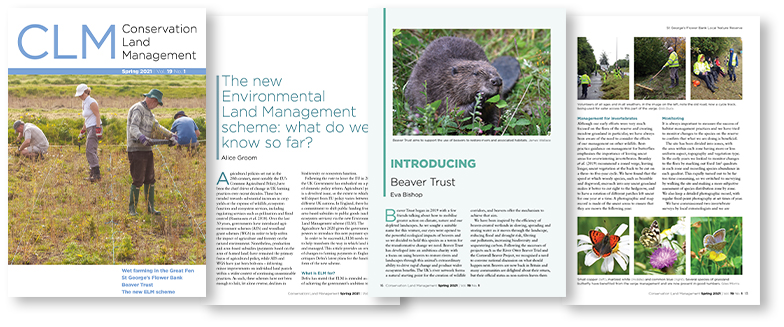The UK’s departure from the EU offers a number of opportunities for the environment, and in particular for the future of farming in the UK. And so, agricultural policy is undergoing a reform and a new payment scheme, Environmental Land Management (ELM), has been introduced in England.  In the latest issue of Conservation Land Management (CLM) Alice Groom, RSPB’s senior policy officer, provides an up to date overview of what we know about ELM so far and the proposed timeline of the seven-year agricultural transition period, and, importantly, highlights the pitfalls and challenges that need to be addressed in order for ELM to be a success. Here you can read a summary of the article.
In the latest issue of Conservation Land Management (CLM) Alice Groom, RSPB’s senior policy officer, provides an up to date overview of what we know about ELM so far and the proposed timeline of the seven-year agricultural transition period, and, importantly, highlights the pitfalls and challenges that need to be addressed in order for ELM to be a success. Here you can read a summary of the article.
What is ELM?
Agricultural policy in the UK has previously meant that farmers and landowners receive payments based on the size of farmed land. While agri-environmental schemes have existed, these alone have not been enough to meet their environmental objectives. And so, following the UK’s departure from the EU, the government has introduced the Environmental Land Management scheme (ELM) in England.
This new payment scheme instead pays farmers for delivering public goods – these are ecosystem services that will benefit us all, such as natural flood management and habitat restoration. Defra has said that ELM is a means to meet six of the government’s 25 Year Environment Plan goals, including clean air and water, climate change mitigation, and protection from environmental hazards.
 Three-component design
Three-component design
ELM will have three components, and although this design has received support, the finer details are currently lacking. The first, Sustainable Farming Incentive, is envisaged to be the most popular and will provide payments based on environmentally sustainable farming and land management, such as tree and woodland management, integrated pest management and promoting wildlife and biodiversity.
The Local Nature Recovery component is more focused on local-scale nature recovery with the aim to encourage farmers to create and enhance semi-natural habitats, and to use farming methods that keep chemical inputs low. Activities that are likely to receive funding under this component include natural flood management, habitat restoration and species management.
The third component, Landscape Recovery, could provide a means to achieve landscape-scale recovery using wilder approaches to farming. If successful, large expanses of habitat, such as woodland and wetlands, could be restored and large-scale activities such as peatland restoration will help contribute to net-zero emissions targets. Collaboration between landowners is key, and it is still unclear if this component can be achieved across smaller land holdings, or if this is limited to large estates.
Agricultural transition
‘The Agricultural Transition’ is a seven-year transition period in which the previous area-based subsidies will be phased out, and the first ELM National Pilot will begin. The transition begins this year, and the current intention is that ELM will be rolled out in 2024.
Although ELM has great potential to support farmers in a shift towards nature-friendly farming and land management, there is still much that remains a mystery. For instance, Defra is yet to provide information on future regulatory standards, details on how payments will operate, the application process, or what the overall annual budget for ELM will be.
The full version of this article can be found in the Spring 2021 issue, and here Alice Groom takes a closer look at each component to discuss its potential in delivering their environmental goals. Other articles featured in this issue include:
- Introducing… Beaver Trust
- Using location-based evidence to prioritise catchment-wide land management
- St George’s flower bank Local Nature Reserve: thirty years of road verge management by a local community
- Wet farming in the Great Fen
 CLM is published four times a year in March, June, September and December, and is available by subscription only, delivered straight to your door. Subscriptions start from £22 per year. Back issues are also available to purchase individually (subject to availability).
CLM is published four times a year in March, June, September and December, and is available by subscription only, delivered straight to your door. Subscriptions start from £22 per year. Back issues are also available to purchase individually (subject to availability).
If you are involved in a conservation project and think your experiences could be useful to other practitioners, we would love to hear from you. If you are interested in writing for CLM feel free to contact us – we will be happy to discuss your ideas with you.






